Archibald Cary Smith (4 September 1837 - 8 December 1911)
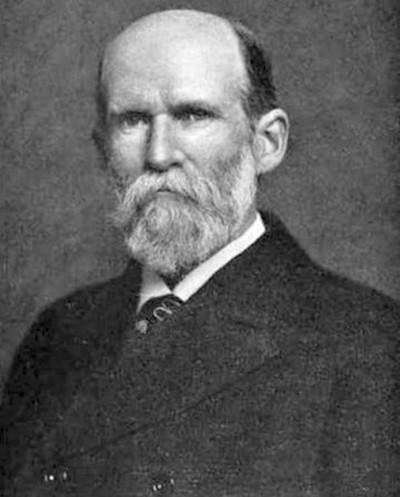
Archibald Cary Smith was a marine painter but most noted as a yacht designer. Born in New York City he learned the shipwright's trade and practiced it in New York City until the mid-sixties. From about 1867 to 1877 he devoted himself mainly to marine painting, which he had studied under the noted Dutch/American artist Mauritz Frederick Hendrick de Haas, and in the 1860s, he was exhibiting at the National Academy of Design and the Pennsylvania Academy. After 1877 he did little painting, devoting himself almost entirely to the designing of yachts and other craft. He died in Bayonne, New Jersey at the age of seventy-four. He was a member of the American Society of Naval Architects and Marine Engineers, of the New York Yacht Club and the Larchmont Yacht Club.
The following text is adapted from the writings of William P. Stephens (in The Rudder magazine, 1903), Knight and MacNaughton's Encyclopedia of yacht designers, and other contemporary sources. Archibald Cary Smith must be recognized as the first designer to use the mathematical treatise of P. R. Marett whose work was continued by Dixon Kemp.
Sketches, by Fred S. Cozzens, of the Mischief, Valkyr, Iroquois, Intrepid, Fortuna, Yampa and Elmina are include in the text below.
The New York traveller who is whirled through West Twenty-third Street on an electric car or down Sixth or Ninth avenue on the elevated railroad will find little in the noisy, busy and not over-cleanly locality to suggest the Chelsea Village of the 1850s. At that time Twenty-third street was uptown, well out in the country, and this particular section was well away from Broadway, even then the main thoroughfare, and close to the open shores of the North River. Quiet, peaceful and eminently aristocratic, the suburb of Chelsea was the home of many wealthy New-Yorkers, who preferred to spend the leisure portions of their lives outside the bustle of the city. By a walk of a few blocks the small boy of the village could feast his eyes from the banks of the Hudson on the infant fleet of the New York Yacht Club, snugly moored off Weehawken on the Jersey shore, or a tramp of a couple of miles downtown and to the eastward would bring him to the great shipyards of Webb and Steers and Westervelt and Bergh, yards whose product was known in every port of the world. That part of the small-boy population which owned to nautical tastes found an easy means of gratifying them by constructing a dam across the gutter near the corner of Ninth Avenue and Twentieth Street, and then taking turns in gangs at the handle of the old wooden pump on the corner which supplied the locality with drinking water, there being no city mains in this section. The pond thus formed was utilized for the sailing of various models of home construction, the toy stores of the day being barren of the wealth of sailing and even steam models which rejoice the up-to-date boy. Prominent among these urchins was one, the son of the Presbyterian clergyman whose church was but a block away, whose whole leisure time was given to the making of models. One model alone, however well she sailed, never satisfied him, but there were always others in various stages of completion from which still more was expected.
At the time when the schooner America was building in the shipyard of William H. Brown at the foot of Twelfth Street, East River, the boy, then about fourteen, had outgrown the gutter pond and was a member of a real model-yacht club, located across the North River in Hoboken. A visit with his father to the shipyard to see the new schooner resulted in a model, as close an imitation as was possible by eye alone, which proved good enough to vanquish all the other models of the club fleet. When the new boat was tried against the older Maria the boy was on hand to see the race. Whatever future the Reverend Edward Dunlap Smith may have mapped out for his son, it became evident that the liking for yachts was more than a mere boyish fad, and at the age of eighteen the boy was allowed to go across the river to Pamrapo, now a part of Bayonne City, where the renowned Captain Bob Fish made his home; his board was paid by his father, and he was to learn all that he could about boats.
“Bob” Fish was a remarkable man, uneducated, with no knowledge of naval architecture, and handicapped by a belief in many of the absurd fallacies of his class, but nevertheless an observer and thinker, a good boat sailor in both small and large craft, and a capable mechanic. He made a great reputation in England, France and Germany through his small catboats; he whittled out the models for many large yachts, both sail and steam, the latter just coming into use; and he served as sailing master for such old-time sportsmen as the Lorillards and William P. Douglas. It was while in the employ of the latter that he took the big schooner Sappho (1867), a failure in her first season, and planned and personally executed the changes which made her a success. He sailed her and other yachts in English waters, and was known and highly esteemed by the leading British yachtsmen. He had the gift of sailing, plenty of hard common sense, and much practical experience, and with greater natural advantages he would have made a successful yacht designer.
Under this mentor young Smith learned to sail a boat, to lay down the lines from the model, to frame and plank the hull, caulk and paint it, fit the joiner work and finally to rig the yacht. There was in those days and some years later a very keen rivalry between the crack modellers, builders and skippers of open sandbag boats about New York Bay. Near to “Bob” Fish was “Pat” McGiehan, then at the height of his fame; across the bay on the Gowanus shore was “Hen” Smedley, builder of the noted “Penny Bridge” boats; and down on Staten Island “Jake” Schmidt was locally famous for a particular model of open "jib-and-mainsail” boat. “Archie” Smith, as the young man was known in those days, was recognized as one of the best racing handlers of small boats about the bay, holding the stick in many noted matches, while one or the other of the Ellsworth boys tended jib sheets for the honor of Bayonne. His first venture in building was a 16-foot open boat, which proved quite fast in trying her in a race at Hackensack, so a match was made with Capt. Fish himself. The betting was all on the master instead of the apprentice, but the latter won. Then came a larger boat, Comet, of 18 feet 3 inches over all. All the boats of the day were built with flat plank keels, straight from forefoot to heel, and with the same draught from end to end, except that a skeg was added aft. Acting on his own initiative, the young designer cut away the forefoot to a draught of but 6 inches, giving the keel about 7 inches round, and immersing the tuck so as to get a good draught aft. Not many years ago the Comet was still afloat about the Harlem River, after a long and successful career, which began with her launching; she was fast from the start, winning many matches from the best professional talent about New York, and bringing triple honors to her designer, builder and skipper. It was about this time that Mr. Smith first fell in with another kindred spirit, the late Robert Center, forming a friendship which lasted until the tragic death of Mr. Center in 1895.
With all his love for yachts, Mr. Smith’s tastes are artistic rather than mechanical, and after mastering the practical details of building and sailing he abandoned this work entirely and took up the study of marine painting, with the intention of following it as a profession. He was very successful, his mechanical knowledge of every detail of construction and every manoeuvre of sailing giving a lifelike quality to his pictures that, to every yachtsman, heightened their purely artistic value. For some years he devoted himself entirely to art, with no idea of returning in any way to the practical side of yachting.
Design principles: mathematics and art
While in England, in 1870, Mr. Center studied the cutter type very thoroughly, and also became interested in the study of theoretical designing as outlined in the late P. R. Marett’s work on Yacht Building, the first book of the kind published. On his return to New York he sought out Mr. Smith to aid him in the design and construction of an iron cutter for cruising. While still with Capt. Fish, Mr. Smith had enjoyed one term’s tuition in marine’ draughting, at a fee of $25.00, with W. W. Bates, an old-time shipbuilder, and this, added to the practical experience in laying down under Capt. Fish, gave him a knowledge of draughting as then practiced in shipyards. The idea of planning a yacht entirely on paper and calculating her centers in advance, without reference to the wooden model, was entirely new; but Marett, though an amateur, was a clear and convincing writer and thoroughly in earnest in his advocacy of systematic designing, so that it was a comparatively easy matter to follow his methods, so far as the actual drawing of the lines and calculation of the elements were concerned.
The task, however, was a difficult one for a beginner in designing. The proposed vessel was radically different in form, rig and ballasting from all American practice, and in addition it was determined to construct her of iron instead of wood. The design of the celebrated iron cutter Musquito, built in 1848, was selected as being in a general way what was desired, and with it as a guide the lines of Vindex were drawn. The dimensions were: Length over all, 62 feet 5 ½ inches; load water line, 55 feet 5 inches; breadth, 17 feet 3 ½ inches; depth, 7 feet ½ inches; draught, 8 feet 9 ½ inches. There was little to guide in proportioning the scantling, the construction of Musquito was not given in the book, and small iron vessels were scarce in those days. As Mr. Center intended the yacht for offshore cruising no chances were taken in light construction; the old boat, broken up in 1899 at City Island, was still in good condition in her joiner work and much of her hull, though the skin had rusted through in places.
As a cruiser, Vindex was very successful, Mr. Center keeping her in commission all winter about Sandy Hook, and living in her all the season round, but as a racer she was, to use Mr. Smith’s comparison, a Dr. Jekyl and Mr. Hyde. About the Sound and New York Harbor she was considered a failure, but East of Newport she was generally respected, especially by those who saw her under reefed mainsail, No. 2 jib and housed topmast, against much larger yachts. The reason for this uneven performance was discovered years later by her designer; the ballast was concentrated within a length of 10 feet, giving her a quick motion which killed her in certain conditions; where the length of the sea fitted her she was very fast.
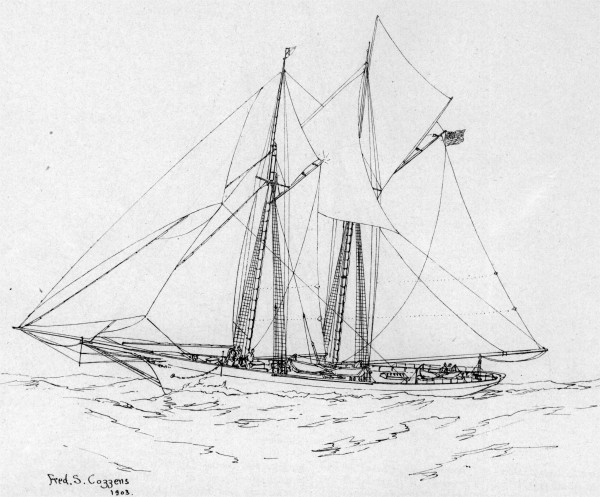
First designs
Vindex carried the full cutter rig, with its amazing complication of tackles and purchases, but its clean, simple spar plan with housing topmast and running bowsprit. In 1873 Mr. Smith was called on to design a schooner, Prospero, for the late C. H. Contoit, a keel vessel of 72 feet water line, and he profited by his experience with Vindex to give her a radically new sail plan. The old square bowsprit solidly built into the hull, with its flying jibboom, dolphin striker and innumerable bobstays and general tangle of gear, then in universal use, was discarded for a simple pole bowsprit, and the foremast was made shorter than the mainmast. This change was greeted with scorn and derision by yachtsmen and sailing masters together, and so strong was the opposition to a change from the established order that after a short time the owner was persuaded to cut down the mainmast and to put in the conventional bowsprit and flying jib-boom. The yacht had a long straight keel and a plumb sternpost, consequently she turned slowly; the same talent which forced the other changes cut down the depth of her keel in order to make her turn more quickly.
Buried among fellow artists in the old studio building on West Tenth Street, and interested in his art work, Mr. Smith gave little attention to yacht designing, making no effort to oppose the existing prejudice against the designer and in favor of the modeller and practical builder. It was only when he was sought out by some progressive yachtsman that he turned from the easel to the draughting board. In 1875 he designed the centerboard sloop Madcap for the late J. R. Busk, a typical Englishman in manner and appearance, but with ultra-American ideas in yachting. In 1878 he was called on by Mr. Lloyd Phoenix to design a sea-going schooner for long cruises, the result being the old Intrepid, still in commission and with a quarter-century reputation as a “good old three-meal-a-day boat.” Built of wood, with a water line of 100 feet, 24 feet 5 inches breadth and 11 feet 6 inches draught, she was a marked departure in model from the schooners of her time, not only the centerboard boats but the keel as well. There were no locked doors and soaped windows in those days, and Poillon’s Yard (Richard and Cornelius C. Poillon), at the foot of Bridge Street, Brooklyn, was within easy reach of New York, so that the construction of the yacht was known to all. It was a pleasure to sit on a pile of knees or oak plank on a Sunday morning, with experts of all grades about, and listen to the comments. Most of these, both verbal and in print, were hostile to the man who presumed to build a yacht without a model and from a plan on paper, and in particular to the model, rig and construction of the yacht herself. She was launched, fitted out, and her owner took her abroad for a couple of years, meeting with an appreciation which was denied her at home. In the following year Norna, a similar yacht, was designed for Mr. Contoit.
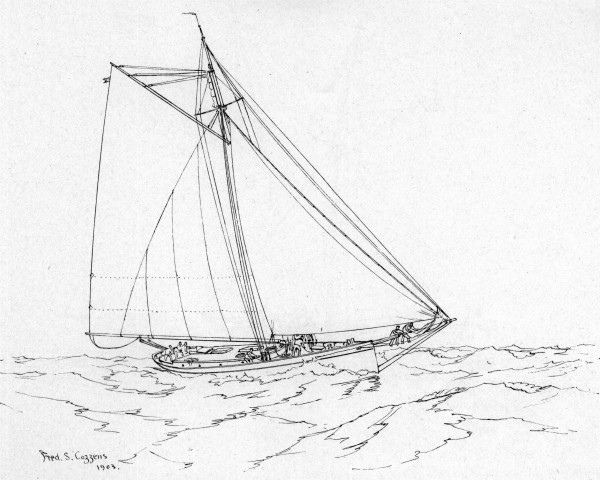
After a successful experience with Madcap, Mr. Busk, in the fall of 1879, came to her designer for a larger sloop. By this time the cutter agitation was well under way, and the yachting world of New York was torn by conflicting theories, feeling running very high between the two factions of sloop men and “cutter cranks.” Though in every sense a sloop, the new boat, Mischief, was a distinct departure from the practice of the day; with a fairly deep hull of iron, the lead ballast being stowed on the garboards, she was greatly superior in ballasting; she had the long mast of the sloop, but with a good length of housing topmast as well, and a single pole bowsprit, in appearance like that of a cutter. In sheer, freeboard and many details of model she differed from the older boats. Mischief proved a success from the start, in the season of 1880, and in the following year she was selected to defend the America Cup [See Atalanta – Unsuccessful challenger for the America's Cup]. In this, the first series of trial races for the selection of the defender, she was matched against Gracie, Hildegard and Pocahontas, the leading boats of the 70-foot class, and two of them much larger. Following Mischief came the compromise cutter Valkyr, a deep centerboard boat of 46 feet water line, with lead keel and cutter rig, in 1881.
By this time the easels had been pushed back against the wall in the little studio, a big draughting table had a permanent place in front of the windows, and models were hung about the walls and piled in the corners. The quiet of the Studio Building was invaded by yachtsmen, captains in pilot coats, sailmakers and riggers. In 1883 Mr. Smith designed for the late Henry S. Hovey of Boston the keel schooner Fortuna, of 95 feet water line, a cruiser well known in foreign waters, the home of her owner for many seasons. She was planned with the pole bowsprit, but her captain declared that such a jib could never be handled, and he had his way, the yacht being fitted with the flying jib-boom and ordinary headgear.
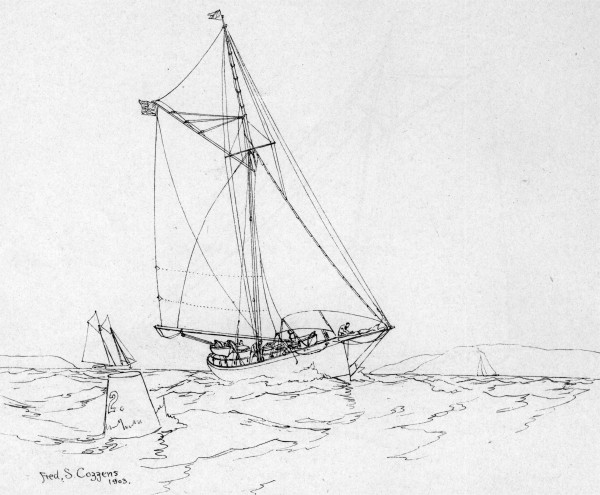
In the following year a very fine little schooner was designed by Mr. Smith for Mr. J. M. Forbes, of Boston, and built by George Lawley & Son under the supervision of Mr. Burgess, then just starting in business as a designer. Harbinger was a cruising yacht, 75 feet over all, 65 feet on the water line, 19 feet in breadth and 6 feet 4 inches in draught, though a centerboard boat. She had a long counter, similar to the English cutters of the day, and a very shipshape sail plan, including the pole bowsprit. Her advent in Eastern waters at this particular time, when all questions of design were being hotly argued, brought about a great change in public opinion. When in the following year Mr. Burgess brought out Puritan, with a similar sheer plan and the pole bowsprit, this type of yacht was christened “the Burgess rig,” and eventually Mr. Burgess was called on to remodel the rig of Fortuna after the new fashion, putting in the pole bowsprit as originally called for in Mr. Smith’s plans. To-day the rig is in use not only on yachts but fishing schooners, and it seems almost incredible that vessels could ever have been loaded down with such useless hamper as the old headgear of the double bowsprit.
One day in 1885 there wandered into the Studio Building a stranger, unknown to Mr. Smith, who wanted a small schooner of very light draught for use in Florida waters, but at the same time capable of making the trip outside from New York to Florida and back. Though not known at the time as a yachtsman, this gentleman, Mr. Chester W. Chapin, knew in a general way what he wanted; the rest he left to the designer. The result was the schooner Whim, built of wood at Poillon’s, 60 feet over all, 55 feet water line, 16 feet breadth and about 2 feet 8 inches draught. When finished in the fall she sailed from New York well-loaded with extra stores for the winter, thus drawing over three feet. In this trim she proved fast and able, making the voyage to Florida without difficulty. When her stores were sent ashore she was ready for ordinary use at her light load line. So successful was she that Mr. Chapin came back in the following summer for a still larger boat for offshore cruising along the coast and in the West Indies. After indicating the size and general purpose of the new boat all the rest was left to the designer; there was no question of racing measurement or of cheating the rule, all that was required being a yacht that was safe, fast and comfortable at sea.
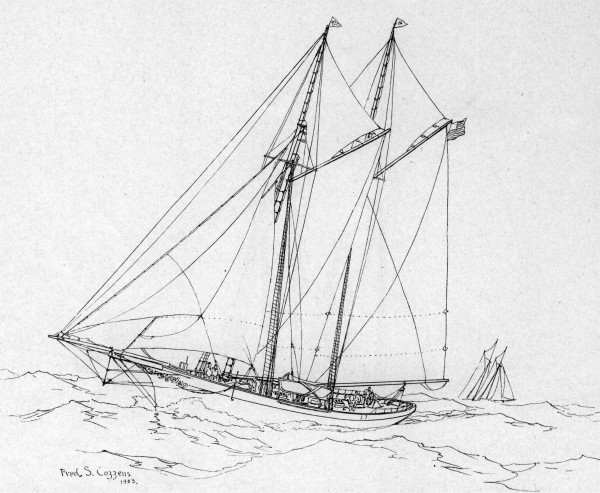
The dimensions selected were 96 feet 3 inches over all, 80 feet 6 inches water line, 21 feet breadth and 10 feet draught. The design showed a moderate fore overhang in the shape of a clipper bow, a rather short counter and good sheer and freeboard, with a deep V section and light bilge. In spite of her depth she carried a centerboard. Built of steel, she was launched under the name of Julia and used for a year with great satisfaction before her owner determined to replace her with a much larger yacht for long sea cruises. The close intercourse engendered between designer and owner in connection with these two yachts resulted in a warm friendship and had a great influence on Mr. Smith’s future work.
One is tempted to diverge here to follow the fortunes of Julia. She was sold and rechristened Iroquois, under which name she has since sailed. In the course of the past fifteen years she has changed hands a number of times, but she has always found a ready sale, and has held her value in a remarkable manner. Though never intended for racing, she has been repeatedly raced, making a long record of prizes. She has been in use year after year as a cruiser, along the Northern coast and in the West Indies. Her most remarkable achievement was the weathering of the great blizzard of March, 1888, in which the yawl Cythera and several pilot boats and coasting schooners were lost, a storm that will always be remembered with respect and dread by those who navigate the Atlantic coast. Under the skilful and prudent handling of Captain Norton, Iroquois rode out the gale in safety, and after the worst was over went on her course uninjured. That she can hold her own with the most modern yachts was proved no longer ago than last September (1902), when in an ocean race of over 200 miles, from New York around Cape May Lightship, with a strong head wind and sea on the return, she won with ease, finishing but six minutes astern of the big Coronet, and beating by two hours the new Endymion and by a much larger margin the new Thistle, both sea cruisers. With much less draught, lead and sail, the little Iroquois made her way to windward in a breeze and sea in which size should have triumphed easily over form.
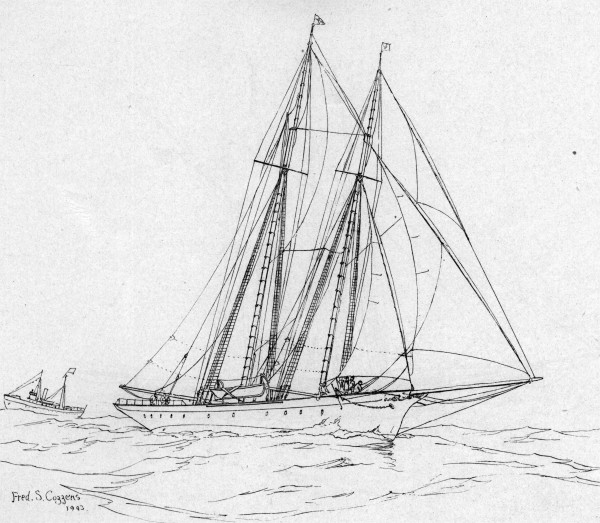
The immediate successor to Julia was the big Yampa, a keel schooner of 110 feet water line and 27 feet breadth, with a draught of 14 feet. She was launched in 1887 and used by Mr. Chapin for several years; he then sold her to that good yachtsman, the late Richard S. Palmer, who cruised with her in all European waters, making several different trips across. On one of these the yacht was inspected by Emperor William at Kiel, the ultimate result being that she was sold to him for the private use of the Empress under the new name of Iduna.
A little more than a year ago an order came from the Emperor to Mr. Smith for a similar vessel of greater size, the now noted Meteor III. Much has been said during the season of the racing qualities of this vessel as compared with smaller yachts designed specially for racing; in this connection it is interesting to note that the letter to the designer describing the type of boat desired, and accompanied by rough sketches of the required accommodation and arrangement, contains the words “cruising type” several times, all underscored. Further than this, the yacht has been raced by men who, while justly celebrated as cutter sailors, have no knowledge whatever of the schooner rig, and have handled her in a manner that would break the hearts of such real masters of the art as Captain Dennis, Leander Jeffrey, “Nat” Watson, or “Dicky” Sherlock.
Long before Yampa was built Mr. Smith had abandoned all painting and devoted his entire time to designing, turning out many cruising yachts and some successful racing yachts, the latter, be it said, always finding a place as cruisers after their racing was done. While battling sturdily for principles and working for real improvements in form, in rig, in construction and in details of rigging and fitting up, he has always shown a reluctance to sacrifice the essential qualities of a vessel for mere speed, to cut away the lateral plane, to underestimate the strength of rigging, and to follow other than a thoroughly mechanical and durable construction.
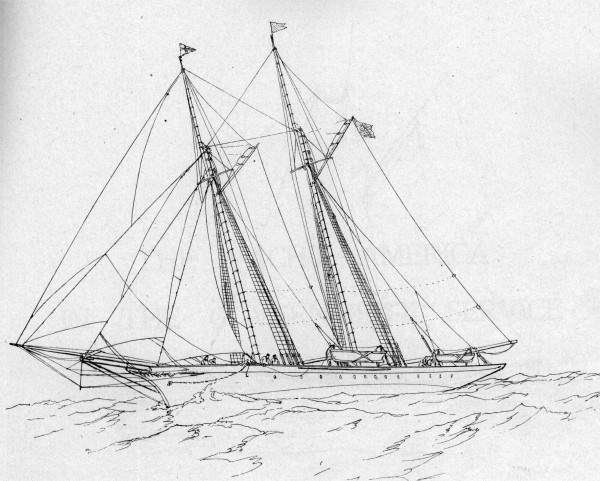
Among many other enterprises Mr. Chapin was interested in the New Haven line of steamers, the vessels being wooden craft of the conventional form. Built mainly on models cut half a century ago and handed down with but slight changes to the present day, with good engines and boilers and elaborately furnished and decorated saloons, this class of vessel, the Sound steamer, has managed to maintain a reputation out of all proportion to the true merits of the model. After the success of Yampa Mr. Chapin suggested to her designer that he should undertake a design for a new Sound steamer which the line proposed to build. The suggestion was declined on the ground of lack of experience in vessels other than sailing yachts, and it was only through the insistence of Mr. Chapin that the work was finally begun. The result was the well-known Richard Peck, a steamer with a record of a trial run at a speed of 20.2 in water not over 30 feet deep, the recognized “Queen of the Sound” until displaced by a younger and larger sister, the City of Lowell, of 320 feet water line. More recently a third large boat, the C. W. Chapin, has been designed by Mr. Smith. All of these differ radically from the standard Sound models, and all embody those principles of design which are so prominent in Mr. Smith’s yachts. The City of Lowell has a record of 9 miles between marks at a speed of 22.25 miles.
Venturing into steam
Mr. Smith’s first venture in steam was the steam yacht Free Lance, designed in 1885, since which time he has turned out a number of power craft, mainly auxiliaries; but one of his notable boats is the steam pilot boat New York. The problem of a steam vessel to displace the famous sailing fleet of New York pilot boats was an old one; two steam pilot boats had been built in England and had proved failures, and a big tug specially selected for the work had been tried about New York and abandoned. The New York was as radical as the Peck in her departure from conventional models; instead of following the ordinary sea-going tugboat she was in effect a big steel lifeboat with sharp floor and the familiar whale. boat bow and stern, with moderate overhangs. This vessel has in several years’ service proved a complete success; she is easy in a sea, whether light after being out from port for some time or loaded with coal and stores as she leaves her station at Stapleton. She never puts her screw out of water, and she can lay-to under a trysail or with the engine under one bell in a heavy gale. Her service requires a constant attendance about the Sandy Hook Lightship, boarding incoming and outgoing vessels with absolute certainty, regardless of weather.
It would seem that the proverbial prejudices of the old sailor had acted in Mr. Smith’s case to counteract that natural gravitation into steam craft which has happened with Mr. Watson and other noted designers. Such steamers as he has built have been successful, but his heart was evidently in the sailing vessel, and he has never followed energetically the more profitable side of designing in power vessels. The introduction of the auxiliary yacht, however, has opened a new and congenial field, as testified by such well-known schooners as Taurus, Tekla I, Tekla II, Oonas, Seneca and the yawl Myiera. Though essentially cruising yachts, all of them have proved fast, and in many cases they have held their own under sail with the fleet without it being suspected that they were each dragging a screw. The most notable of Mr. Smith’s auxiliaries is the steam schooner Genesee, of 110 feet water line, built two years ago to the order of Gen. James S. Watson, who had previously owned and cruised abroad in the schooner Lasca, of 90 feet water line, also designed by Mr. Smith. This fine vessel, just back from her second cruise abroad, has made 56 nautical miles in a watch, under sail alone; since her return her owner has received an offer of more than her cost price.
One class of yachts in which Mr. Smith has been specially successful, though but little is heard of them, is the cruising schooner or yawl of 45 to 60 feet water line, mostly centerboard craft of moderate and in some cases of very light draught. The experience gained in Whim has led to the construction of Polly, a yawl designed for Mr. Chapin, Helene, and many similar cruisers with more than the average speed.
With the new line of work opened up by the success of the Peck, a removal from the remote location and contracted quarters of the Studio Building became necessary, and of late years Mr. Smith, with his associate, Mr. Henry C. Barbey, has been installed in a suite of offices in a big down-town building, where there is room for a force of draughtsmen and assistants. With little taste for mechanical details, Mr. Smith has always devoted himself conscientiously to the planning of the construction, arrangement, spars, ironwork and rigging, and to that mass of dull detail through lack of which many a promising design is ruined. His early training taught him that the mere mental conception of a certain form availed little unless this form, when realized in wood or metal, was accompanied by strong and practical gear and spars. His work only begins with the completion of the lines, as every detail of construction and fitting must pass under his eye at least up to the time of the trial trip or first race.
For many years he relied on the aid of but a single draughtsman, attending personally to details which had no interest of their own for him.
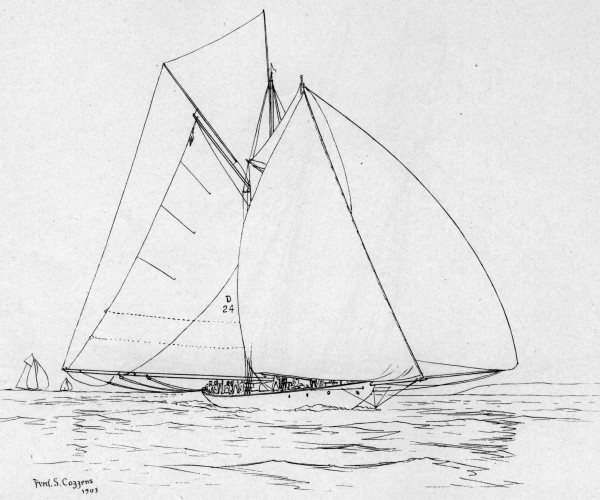
Of recent years he has confined his work mainly to the planning of the hull, his young partner taking charge of the calculations, specifications, accommodations, plans and the innumerable details of fitting and furnishing. Under the firm name of Cary, Smith & Barbey they have designed the City of Lowell, the Chester W. Chapin, the New York, Genesee, Telka I, Telka II, Laurus, Oonas, and other auxiliaries, and the racing schooners Elmina and Muriel, with the big Meteor III. At the present time they have in hand another interesting auxiliary, a two-masted sailing schooner, of 120 feet water line, similar to Meteor III, but with steam power and screw, for Albert C. Bostwick. She will be a veritable cruiser, with the screw merely as an auxiliary.
The later racing yachts from Mr. Smith’s board present an interesting problem to all students of design. The tendency of designers the world over for a dozen years past has been toward a smaller area of midship section, a harder bilge to the shallow body of the hull, and a thinner keel or fin. The one exception to this rule is found in such of Mr. Smith’s yachts as Amorita, Elmina and Muriel, three schooners which have been remarkably successful. All of these boats have deep V sections, broadly speaking, slack on the bilge and very full below. With this section they go to windward of craft with a high center of buoyancy, very low ballast, and deep, flat fins, that should be most effective, according to theory, in lateral resistance. Amorita, with a draught of 12 feet, required a centerboard of some size, but the later boats, of the same dimensions and general type, but improved in detail of form as well as in construction, require no centerboard. Though each was originally fitted with a board, it has since been discarded as unnecessary. There is nothing specially strange in the fact that all of Mr Smith’s cruising boats should class as normal and free from tax on freak features under the latest rules, such as the present Y. R. A., the Hyslop and the new Herreshoff rule; but the same is true of such racing craft as Amorita, Elmina and Muriel, whose speed is attested by many races, their moderate proportions relieve them of the taxes imposed on the great majority of modern fast cruisers, to say nothing of the avowed racing machines.
Conclusion
Starting with none of the advantages of the present day, and at a time when nearly all the accepted ideas on yacht modelling and building were false and misleading, Mr. Smith has worked out his own methods by long and hard study. Of late years he has perfected a system of fairing the design by lines of his own, the result being seen in all his newer vessels in the perfect sweep of every fore-and-aft line from the stem to the transom. All of these craft are free from the fashionable eccentricities of form, and show sections full about the garboards, lateral planes of liberal extent with long keels, and forms that with no hollows are clean and easy throughout and free from the strange lumps, warts and wens which, distributed over the ends of the water line, are popularly assumed to give speed. He was quick to adopt the conclusions of Mr. John Hyslop of the value of the displacement curve in designing when first made public many years ago. With Hyslop and Robert Center, he developed the Seawanhaka Corinthian Yacht Club hanicap rule when he was that club's measurer from 1875 to 1883. All his subsequent practice has been in accord with this theory. It is interesting to note that the curve of areas of the little Comet, as shown by subsequent study, she having been built long before the theory was established, have been deliberately followed in planning such craft as the big Peck, Lowell and Chapin.
Mr. Smith has been a member of the New York Yacht Club since 1872, serving as measurer from 1874 to 1882; and of the Seawanhaka Corinthian Yacht Club since 1874, being measurer from 1875 to 1883. While never prominent as a club man he has played an important part in the technical work of both clubs, especially in all relating to measurement. His personal tastes are strongly domestic and artistic, and his time, outside of business, is devoted to the society of his wife and daughter. The simple wants of his philosophic nature ate amply filled in his home in Pamrapo, not far from the old shop of Bob Fish, where a plain and unpretentious exterior gives little hint of the comfortable interior, whose books and pictures suggest the artist or the poet rather than the prosaic planner of lead keels.
